MSI Z97 Gaming 5 Motherboard Review: Five is Alive
by Ian Cutress on October 6, 2014 10:00 AM EST- Posted in
- Motherboards
- Intel
- MSI
- Z97
System Benchmarks
Power Consumption
Power consumption was tested on the system while in a single MSI GTX 770 Lightning GPU configuration with a wall meter connected to the OCZ 1250W power supply. This power supply is Gold rated, and as I am in the UK on a 230-240 V supply, leads to ~75% efficiency > 50W, and 90%+ efficiency at 250W, suitable for both idle and multi-GPU loading. This method of power reading allows us to compare the power management of the UEFI and the board to supply components with power under load, and includes typical PSU losses due to efficiency. These are the real world values that consumers may expect from a typical system (minus the monitor) using this motherboard.
While this method for power measurement may not be ideal, and you feel these numbers are not representative due to the high wattage power supply being used (we use the same PSU to remain consistent over a series of reviews, and the fact that some boards on our test bed get tested with three or four high powered GPUs), the important point to take away is the relationship between the numbers. These boards are all under the same conditions, and thus the differences between them should be easy to spot.
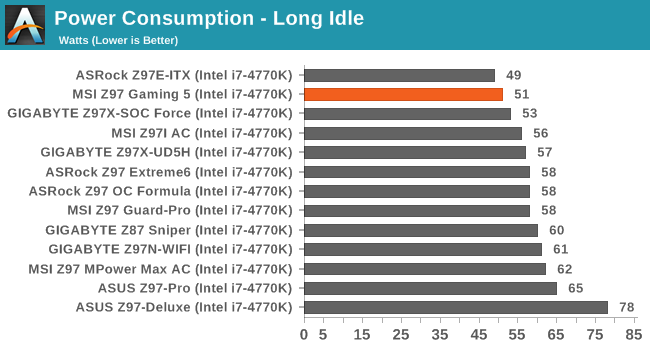
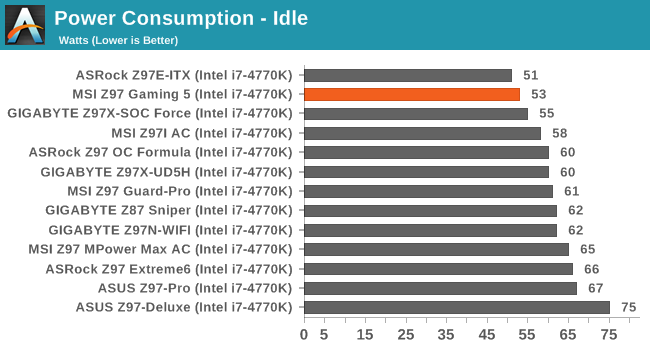
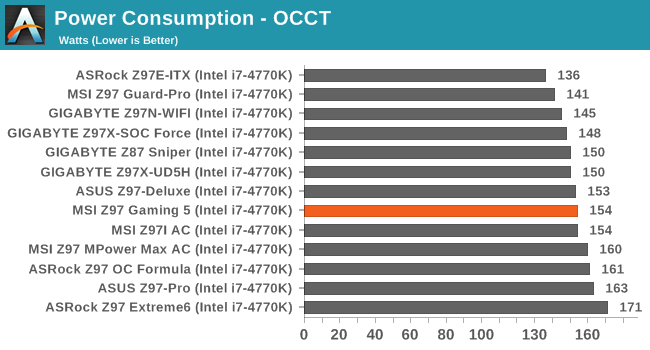
MSI’s idle power consumption numbers are nice and low, although this could potentially be pushed down further with Eco Center.
Windows 7 POST Time
Different motherboards have different POST sequences before an operating system is initialized. A lot of this is dependent on the board itself, and POST boot time is determined by the controllers on board (and the sequence of how those extras are organized). As part of our testing, we look at the POST Boot Time using a stopwatch. This is the time from pressing the ON button on the computer to when Windows 7 starts loading. (We discount Windows loading as it is highly variable given Windows specific features.)
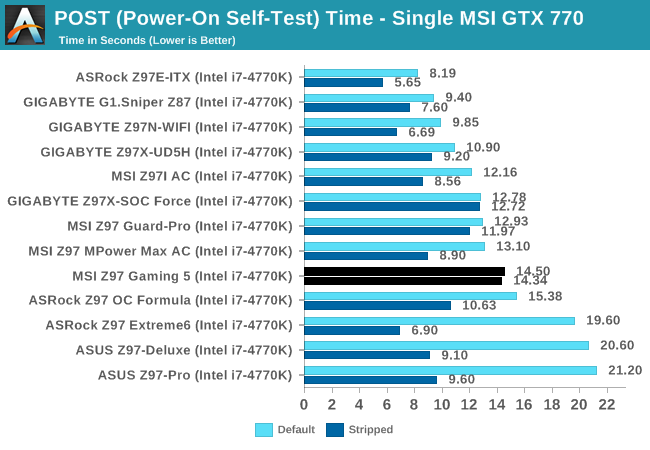
Z97 should be a good target for POST optimization, although the MSI clocks in at over 14 seconds in both stock and stripped timings.
Rightmark Audio Analyzer 6.2.5
Rightmark:AA indicates how well the sound system is built and isolated from electrical interference (either internally or externally). For this test we connect the Line Out to the Line In using a short six inch 3.5mm to 3.5mm high-quality jack, turn the OS speaker volume to 100%, and run the Rightmark default test suite at 192 kHz, 24-bit. The OS is tuned to 192 kHz/24-bit input and output, and the Line-In volume is adjusted until we have the best RMAA value in the mini-pretest. We look specifically at the Dynamic Range of the audio codec used on board, as well as the Total Harmonic Distortion + Noise.
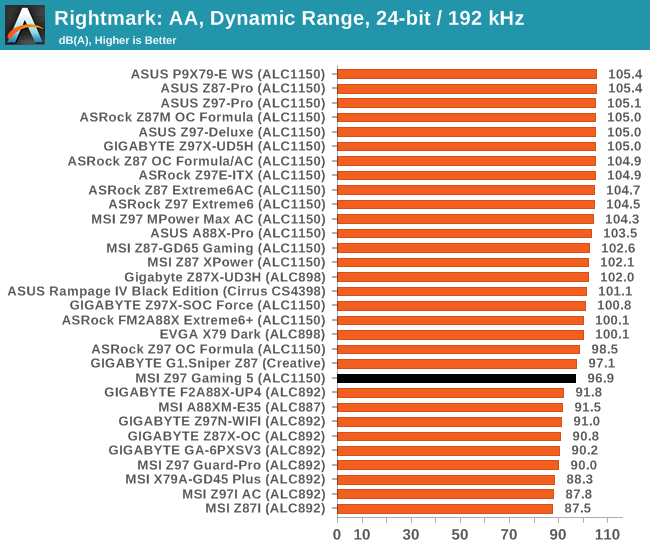
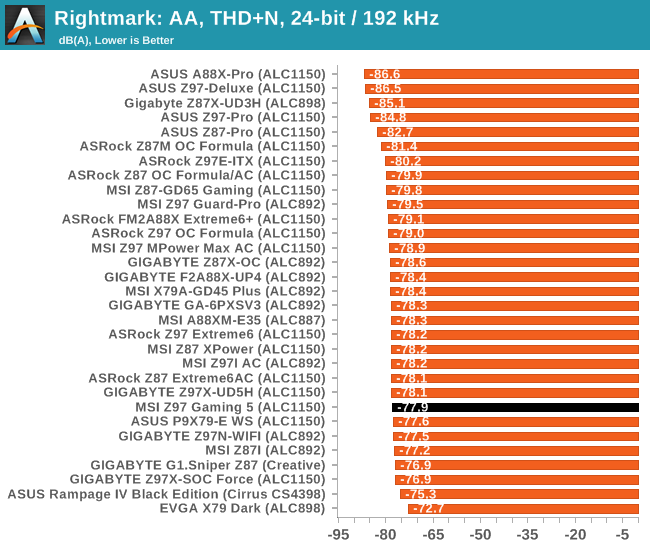
Similar to the Z97 OC Formula, the results of an enhanced ALC1150 on Z97 seem relatively low compared to Z87 testing. The use of extra tools such as Sound Blaster get in the way of our testing by artificially adjusting the signal, and even when turned off in the software they never seem to be turned off completely, hence why base ALC1150 models tend to do better in our test. We mentioned this to MSI before finishing up the review, and they showed us results nearer 104 dBA with the latest drivers which should be available online soon.
USB Backup
For this benchmark, we transfer a set size of files from the SSD to the USB drive using DiskBench, which monitors the time taken to transfer. The files transferred are a 1.52 GB set of 2867 files across 320 folders – 95% of these files are small typical website files, and the rest (90% of the size) are small 30 second HD videos. In an update to pre-Z87 testing, we also run MaxCPU to load up one of the threads during the test which improves general performance up to 15% by causing all the internal pathways to run at full speed.

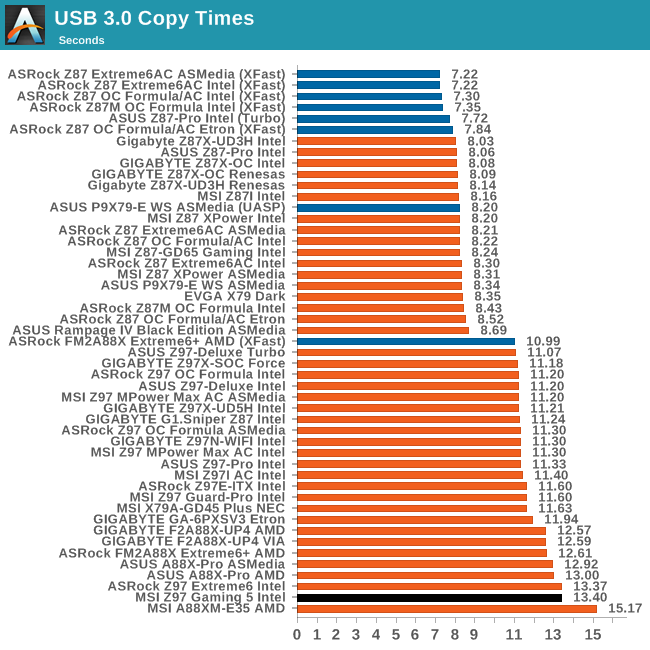
Every so often, MSI’s USB tests seem to be slower than everyone else. I am not sure why that is. Sometimes motherboard manufacturers will suggest different BIOS settings for when things are tested, but as a general rule at AnandTech I ignore those completely. MSI doesn’t offer such suggestions, but the results speak for themselves: a drop in USB 2.0 and USB 3.0 copy speed.
DPC Latency
Deferred Procedure Call latency is a way in which Windows handles interrupt servicing. In order to wait for a processor to acknowledge the request, the system will queue all interrupt requests by priority. Critical interrupts will be handled as soon as possible, whereas lesser priority requests such as audio will be further down the line. If the audio device requires data, it will have to wait until the request is processed before the buffer is filled.
If the device drivers of higher priority components in a system are poorly implemented, this can cause delays in request scheduling and process time. This can lead to an empty audio buffer and characteristic audible pauses, pops and clicks. The DPC latency checker measures how much time is taken processing DPCs from driver invocation. The lower the value will result in better audio transfer at smaller buffer sizes. Results are measured in microseconds.
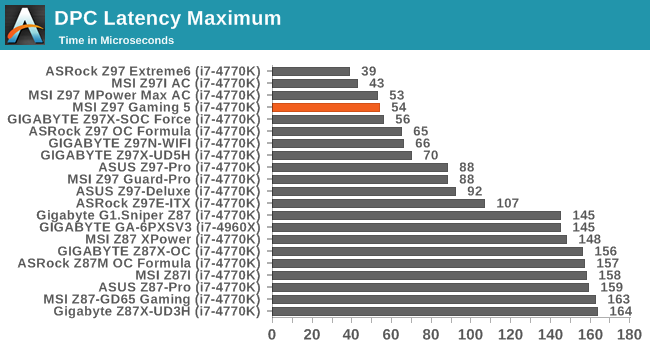
To counterbalance the USB speed issue, the MSI Z97 Gaming 5 does particularly well in our DPC Latency tests. In fact three of the top four positions in this benchmark are populated by MSI.











45 Comments
View All Comments
gw74 - Monday, October 6, 2014 - link
also, who said anything about "mainstream"? anandtech is a website written by enthusiasts for enthusiasts, and noobs interested in future-proofing like me. your point is?Salvor - Monday, October 6, 2014 - link
While I am definitely an enthusiast, I'm also not rich, and could never justify wasting money on the x99 chipset. At this point DDR4 is still to expensive to make sense unless you have money to throw away.ruggia - Monday, October 6, 2014 - link
well, you asked why would someone want it instead of DDR4.So he replied: mainstream
Did you meant to say why would an enthusiast want it?
Teizo - Tuesday, October 7, 2014 - link
Enthusiast means educated. It doesn't necessarily mean wasting money on unnecessary parts.gw74 - Tuesday, October 7, 2014 - link
(a) There will be a time when DDR4 will be essential and value for money. that is not today. (b) There will be a time quite soon when DDR4 is more common and slightly cheaper than now but still not strictly necessary for today's games, but buying it will be cheaper than buying DDR3 now and replacing with DDR4 later. the rational buyer would buy at that point. My question is will that point ever come and when do you think it will come?Nite Owl - Monday, August 24, 2015 - link
I thought an enthusiast was some one that was enthusiastic about cool new stuff and likes to build. No where in "enthusiast" does it say you have to pay loads of money and get ripped off on bran spanking new tech. your 3k tower is going to cost me 1500 next year! Mean while my setting are just as high as yours and well above 30fps... lol @ suckers! =PC'DaleRider - Tuesday, October 7, 2014 - link
LOL at the future proof comment. The ONLY way to future proof yourself in computers is not to spend your money.gw74 - Tuesday, October 7, 2014 - link
it's not binary choice of futureproof or not futureproof. better futureproofing. parts which will play newest games at highest settings per dollar without needing replacement for longest time. perhaps futureproof is the wrong word. how about "maximum longevity per dollar". bootable PCIE SSD, DDR4, 1440p, 802.11ax, CPU pipeline, GPU pipeline, and choose when to buy based on release dates/cost curve of these.spidey81 - Tuesday, October 7, 2014 - link
It's been proven time and again that the best way to "future proof" a gaming rig in particular is spend up on the GPU. With the current crop of Intel CPU's you're only seeing minor performance improvements in compute capability. I know plenty of people still using sandy bridge processors for gaming and multipurpose systems. Also, the biggest benefit from DDR4 will be for rendering, transcoding, onboard graphics, and the like. Games show little benefit from increased RAM speeds. PCIE gen 3 is the best interface we'll see for some time to come and x8 speed will be enough bandwidth for decent dual GPU setups. Anything more than that you'll be spending enough to justify an X99 platform.niceyuk - Saturday, November 1, 2014 - link
Theres no such thing as future proofing.